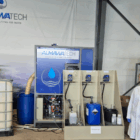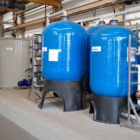A ball valve is a type of valve that uses a rotating ball with a bore to control the flow of liquids or gases. The position of the ball determines whether the flow is open, closed or throttled.
In the open state, the medium flows through the bore of the ball, while in the closed state the ball blocks the passage by rotating 90°. This ability to switch quickly between open and closed makes the ball valve a preferred valve type in many industrial applications.
Structure and components
Ball with through hole
The core of the ball valve. The bore enables the flow in the open state.Housing
Manufactured from materials such as stainless steel, brass or plastic, depending on the application and chemical resistance.Seals and seat rings
Usually made of PTFE (polytetrafluoroethylene) or elastomers to ensure a tight seal.Actuating lever or drive
For manual or automated control of the ball rotation.Spindle
Connects the lever or drive to the ball and ensures the rotational movement.
Technical specifications
- Nominal diameter (DN): Typically from DN10 to DN500, depending on the flow rate.
- Nominal pressure (PN): Up to 100 bar or more in special versions.
- Temperature range: -20 °C to over 200 °C, depending on seal material and housing.

Photo: Ball valve as sampling valve and various diaphragm valves on one of our research systems, installed in the ALMA module technical room container
Types of ball valves
Single ball valve
For standard applications with manual operation.Flanged ball valve
With flanges for easy integration into pipe systems.Multi-port ball valve
Allows the control of multiple flow directions in complex pipe systems.Automated ball valve
Equipped with pneumatic or electric actuators for remote control.
Applications
Industrial water treatment
For controlling cleaning processes, dosing chemicals and shutting off water flows.Waste water treatment
For the control of sludge and chemicals in precipitation and neutralization processes.Chemical industry
Excellent for transporting aggressive liquids such as acids and alkalis.Food and beverage industry
Stainless steel ball valves ensure hygienic conditions.
Advantages
- Quick and easy operation: Simple switching between open and closed.
- Tightness: High sealing effect even at low pressure differences.
- Durability: Low wear due to reduced mechanical stress on the components.
- Flexibility: Suitable for liquids, gases and solids-laden media.
Challenges
- Seal fatigue: High temperatures and aggressive media can shorten the service life of the seals.
- Cavitation and risk of pressure surges: At high flow rates, there is a risk of pressure surges or cavitation.
Conclusion
Ball valves are an essential component of modern water and wastewater technology. They offer a reliable, flexible and durable solution for controlling liquids and gases in a wide range of industrial processes. With their wide range of materials and versatile applications, they make a decisive contribution to the efficiency and safety of systems.
For further information on our products, please feel free to contact us at any time!







